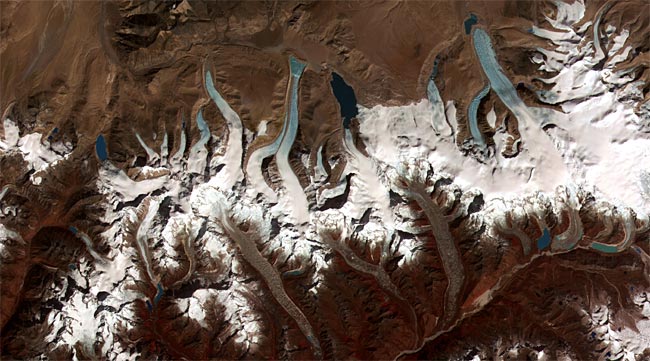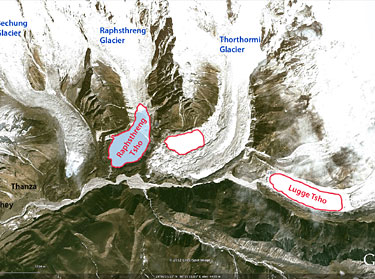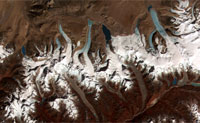They creak and groan, and crackle and rumble. And sometimes they roar.
These days glaciers have lots to complain about. But are we listening?
American climber Ed Viesturs developed a survival strategy he calls 'listen to the mountain'. Before setting off on a dangerous climb to the summit, he sits and meditates, and takes time to listen to the mountain—to figure out if the mountain sounds welcoming or dangerous, to determine if it is about to unleash avalanches or not. For Viesturs the climber, listening to the mountain is a matter of life and death. And for millions of South Asians, reading the glaciers may be a matter of urgent survival. Here's why:

This NASA image shows glacial meltdown on the Tibet-Bhutan border from a satellite perspective. The upper section of the image shows glaciers in Tibet, while the lower section shows glaciers in Bhutan. As glaciers melt, they form glacial lakes that swell in size. If a glacial lake bursts, it can cause flash floods that can sweep away roads, bridges, and entire villages. To the far lower right of the NASA image is Lungge Tsho, a glacial lake in Bhutan that had a dangerous outflow in 1994. Flash flooding from glacial lake outbursts has happened more than 30 times in the last 70 years in Nepal. There are around 3,300 glaciers in Nepal: roughly two-thirds of them contain glacial lakes. Similar problems exist in Bhutan and Tibet.
Bhutan has identified scores of sites for potential GLOFs (Glacial Lake Outburst Floods) within its borders, of which 25 are at extremely high risk of bursting. These GLOFs exist within Tibet: at the time of the Sichuan earthquake, video footage emerged of the PLA troops dynamiting the walls of glacial lakes before they could become bigger.
the rain of black soot
The Himalayan range sits between the nations of China and India—which are the world's worst offenders for carbon emissions. One factor speeding up the meltdown of Himalayan glaciers is the rain of black soot that derives from China and India. According to scientific studies, black soot deposition at some Himalayan glaciers increased 30 percent between 1990 and 2003. Shimmering white glaciers in theory reflect the sun's heat, while 'dirty' glaciers (caused by black soot depositions) will do the exact opposite: they will start absorbing the sun's rays, thereby accelerating glacial meltdown. Most soot in the region comes from diesel engines, coal-fired power plants, and outdoor cooking stoves. Multiply the cooking stoves by several billion to get an idea of how much black soot may be floating around in the air.
For more research on this, visit this page at NASA:
www.nasa.gov/topics/earth/features/carbon-pole.html
Highly reflective white ice-sheets near the Arctic and Antarctic normally bounce 70 percent of incoming sunlight back into space. If melting turns ice-sheets into open ocean, this will no longer bounce light back. Instead, open ocean will absorb 90 percent of the sunlight striking it, and convert it back into heat. A similar scenario could take place as glaciers gradually melt down in the Himalayas.
unprecedented carbon emissions
The amount of global warming gases sent into the atmosphere made an unprecedented jump in 2010, according to the US Department of Energy's latest world data on carbon dioxide emissions. "It's big," said Tom Boden, director of the Carbon Dioxide Information Analysis Center Environmental Sciences Division at the DOE's Oak Ridge National Laboratory in Tennessee. "Our data go back to 1751, even before the Industrial Revolution. Never before have we seen a 500-million-metric-ton carbon increase in a single year," he said. The 512 million-metric-ton increase amounted to a near six percent rise between 2009 and 2010, going from 8.6 billion metric tons to 9.1 billion.
Large jumps, measured from C02 emissions released into the atmosphere as a result of burning coal and gas, were visible in China, the United States and India, the world's top three polluters. China alone was the biggest polluter with a spike of 212 million metric tons of carbon in 2010 over 2009, compared to 59 million metric tons more from the United States and 48 million metric tons more from India.
"Science tells us that we are driving in a fog headed toward a cliff but are unsure just how far away it is," said climate scientist Scott Mandia. "Given this warning, it is quite foolish to be stepping on the accelerator."

28 05 43 N, 90 17 29 E
Lugge Tsho Glacier Lake, in Bhutan, had a dangerous outflow in 1994. Thanza and Tenchey, two villages downstream, lie directly in the path of a flash flood that might be created by Lugge Tsho. In the Google Earth image, the lake appears to be iced over. Glacial lake outburst flood (GLOF) events have occurred in the high-mountain areas of the Bhutan Himalaya during the past 50 years and have increased in recent years. Around 40 glacial lakes in Bhutan have been listed as highly hazardous.
